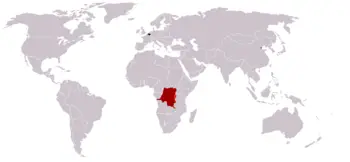Belgian colonial empire
The Belgian colonial empire consisted of three colonies possessed by Belgium between 1901 to 1962. This empire was unlike those of the major European imperial powers since 98% of it was just one colony (about 76 times larger than Belgium)—the Belgian Congo—and that had originated as the private property of the country's king, King Leopold II, rather than being gained through the political action of the Belgian state. It was, however, the third largest colonial territory in Africa. In contrast, the possessions of Belgium's more powerful neighbor, Germany came sixth in size. There was a tendency within Belgium to refer to its overseas possessions as 'the colonies' rather than 'the empire' - unlike Britain, France, Germany or Austria, Belgium never had a monarch called an "Emperor".[1] The phrase "Belgian empire" is sometimes used in a derogatory sense in Britain and France to refer to the European Community, head-quartered in Brussels[2]
Congo Free State
Belgium itself had only been independent since 1830, prior to that it was part of the Netherlands (and had a role in that country's colonies) or of France, or was governed by Spain or Austria. By the time independent Belgium might have been in a position to consider an overseas empire, major imperial powers such as the United Kingdom and France already had the most economically promising territories for colonization within their spheres of influence. Leopold II tried to interest his government in establishing colonies but it lacked the resources to develop the candidate territories and turned down his plans.
Leopold II exploited the Congo for its natural rubber which was starting to became a valuable commodity. His regime in the Congo operated as a forced labor colony, with murder and mutilation as punishment for villagers who did not collect and supply the rubber quota they were given. It is estimated that millions of Congolese died during this time.[3]
Although the Congo Free State was not officially a Belgian colony, Belgium was its chief beneficiary, in terms of its trade, the employment of its citizens, and the wealth which Leopold extracted which was used for the construction of numerous fine public buildings in Brussels, Ostend and Antwerp. This led to him being remembered in Belgium today as the 'Builder-King'. Through the Royal Trust he left most of his property to the nation.
The Belgian Congo
In 1908 in order to defuse an international outcry against the brutality of the Congo Free State, the Belgian government agreed to annex it as a colony, named the Belgian Congo. It also annexed Katanga, a territory under the Congo Free State flag which Leopold had gained in 1891 when he sent an expedition which killed its king, Msiri, cut off his head and hoisted it on a pole.[4] Leopold had administered Katanga separately, but in 1910 the Belgian government merged it with the Belgian Congo. The Belgian Congo was one of the three colonies Belgian ocupied.
The Belgian Congo became independent on 30 June 1960.
Tientsin concession zone
Along with several other European powers and the United States of America, as a result of the Boxer Rebellion, Belgium also gained a Concession (Chinese: zujie 租界 of a couple of square kilometres in Tientsin (or Tianjin; a Chinese Treaty port). This was essentially a trading post rather than a colony, and reverted to China in 1930.
Ruanda-Urundi
During the East African Campaign of World War I, the north-east part of German East Africa, Ruanda-Urundi, was invaded by Belgian and Congolese troops in 1916 and was still occupied by them at the end of the war in 1918. As part of the Treaty of Versailles the major part of German East Africa was handed over to British control but Ruanda-Urundi, twice the size of Belgium but only about 2% of the size of the Congo, was confirmed as a Belgian colony by a League of Nations Mandate in 1924, later renewed as a United Nations Trust Territory. The territory was granted independence in 1962 as the separate countries of Rwanda and Burundi in 1962, bringing the Belgian colonial empire to an end.
Following the independence of both colonies, Belgium kept strong but eventful political and economical relationships with the three succeeding African republics, which still refer to the 'special relationship' whenever that seems to suit: Zaire (now Democratic Republic of the Congo), Rwanda and Burundi.
See also
- History of Belgium
- [Scramble for Africa]]
- imperialism
- colonialism
Notes
- ↑ In the Dutch language, the name used is 'Belgische koloniën', as on Dutch Wikipedia, and an Internet search of the equivalent of 'Belgian Empire' gets only a handful of results. In French the term 'colonies belges' is far more common than 'empire colonial belge'
- ↑ European Foundation, quoting Le Monde retrieved December 9th, 2007
- ↑ Religious Tolerance Organisation: The Congo Free State Genocide. Retrieved 14 May 2007.
- ↑ De Pont-Jest, René (1892). "L'Expédition du Katanga, d'après les notes de voyage du marquis Christian de Bonchamps". Le Tour du Monde. Retrieved 5 May 2007. See also Christian de Bonchamps.
Template:Colonialism
{ {Credit|206011186}}
